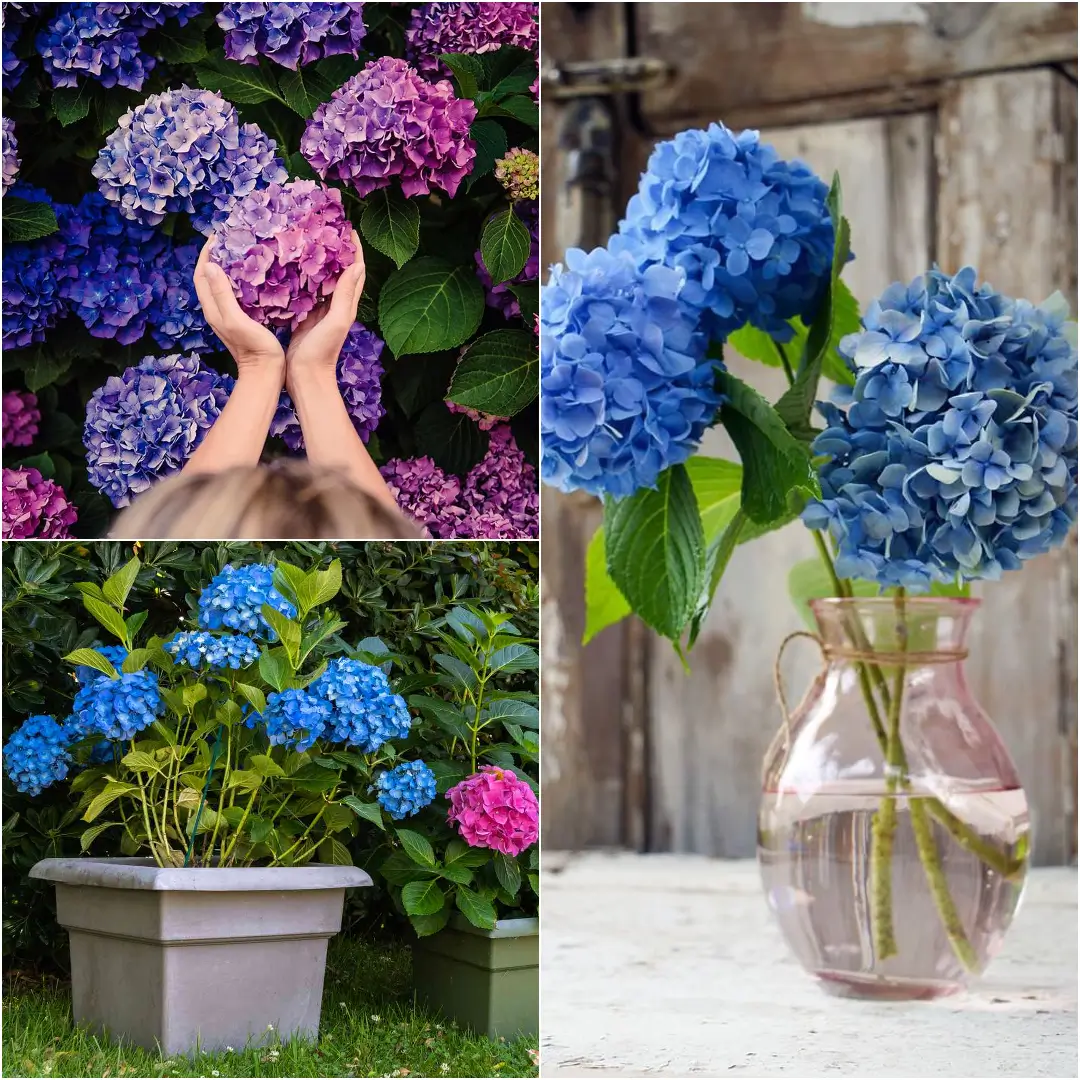For Hydrangeas, these beloved garden staples are known for their large, showy blooms and adaptability. Whether you’re a seasoned gardener or just starting out, understanding how to care for hydrangeas will help you nurture these stunning plants so they thrive in your yard. While they may look delicate, for hydrangeas, proper care is fairly simple once you understand their specific needs. In this guide, I’ll walk you through everything you need to know, from the right light conditions to watering tips, pruning techniques, and even changing their flower color!
What You Need to Know About Hydrangeas
Hydrangeas come in a variety of species, but some of the most common ones you’ll encounter are Hydrangea macrophylla (bigleaf hydrangea), Hydrangea paniculata (panicle hydrangea), and Hydrangea arborescens (smooth hydrangea). Each species has unique care requirements, so it’s essential to identify which type you’re working with. However, there are some general care guidelines that apply to most hydrangeas.
Light Requirements for Hydrangeas
When it comes to caring for hydrangeas, lighting needs can vary significantly based on the species and variety you’re growing. For Hydrangeas, such as Hydrangea macrophylla, partial shade is typically ideal, while Hydrangea paniculata is more tolerant of full sun. Always check the specific care requirements for hydrangeas you’re planting to ensure the best growth conditions.
How Much Sun Do Hydrangeas Need?
Hydrangeas prefer a balance of sunlight and shade. Typically, they need morning sun and afternoon shade to protect them from the heat of the day. Too much direct sunlight can cause leaf scorch, while too little sun might prevent the plant from flowering.
Tips for Positioning Your Hydrangea
- If you live in a hot climate, planting hydrangeas where they get shade during the hottest part of the day is critical.
- In cooler climates, hydrangeas can handle more direct sunlight, but they still need some protection during peak heat.
Always check the plant’s care tag for specific lighting needs before planting.
The Best Soil for Hydrangeas
Hydrangeas are quite picky about their soil. They need well-drained, nutrient-rich soil to grow, and while they can adapt to different types of soil, getting the right balance of moisture is key.
Creating the Ideal Soil Environment
Hydrangeas thrive in soil that holds moisture without becoming waterlogged. Aim for soil that drains well but still retains enough moisture to support healthy root systems. Loamy soil is perfect for this balance.
Adding Organic Matter
Organic matter such as compost or well-rotted manure can greatly improve the quality of your soil. This helps ensure that the soil remains both rich in nutrients and well-drained. Mix compost into the soil before planting your hydrangeas, and consider adding mulch around the base to help retain moisture.
Watering Hydrangeas: Finding the Sweet Spot
Hydrangeas are thirsty plants, but it’s important not to overwater them for hydrangeas. Newly planted hydrangeas need extra attention when it comes to watering.
How Often Should You Water Hydrangeas?
For newly planted hydrangeas, it’s important to water every one to two days to help them establish strong roots. Once your hydrangeas are established, you can cut back to watering when the top inch of soil feels dry to the touch. This typically means watering once or twice a week, depending on the weather and your soil type.
Best Time of Day to Water Hydrangeas
Watering in the morning is ideal. This gives the plant plenty of time to absorb the water throughout the day and allows the leaves and soil to dry out by evening, reducing the risk of fungal diseases.
Fertilizing Hydrangeas for Optimal Growth
Hydrangeas benefit from regular fertilization, especially if you want them to grow vigorously and bloom abundantly.
When and How to Fertilize Hydrangeas
For best results, use a general-purpose fertilizer like 10-10-10 or 12-4-8. Apply the fertilizer twice a year—once in the spring and again in early fall. When applying fertilizer, make sure to spread it around the drip line of the plant’s branches rather than directly at the base. This ensures the roots can absorb nutrients without risking fertilizer burn.
Avoid Over-Fertilizing
Too much fertilizer can cause the plant to produce lots of leaves but few blooms. Always follow the recommended dosage on your fertilizer package to avoid overfeeding your hydrangeas.
Temperature Tolerance and Climate Zones
Hydrangeas are incredibly versatile and can be grown in a variety of climates, but knowing your plant’s hardiness zone is crucial for proper care.
Hydrangeas and Temperature
Most hydrangeas grow well in USDA hardiness zones 3 to 9, meaning they can handle temperatures ranging from -40°F to 30°F. If you live in a colder region, you’ll want to take extra care to protect your plants during winter.
Winter Protection Tips
To overwinter hydrangeas:
- Water thoroughly before the first frost.
- Apply a thick layer of compost or mulch around the base to insulate the roots.
- If your hydrangea is in a pot, wrap it in burlap for added protection from freezing temperatures.
Pruning Hydrangeas: Timing Is Everything
Pruning hydrangeas is an important part of maintaining their health and encouraging blooming. But did you know that pruning at the wrong time can actually reduce the number of flowers?
How to Prune Hydrangeas Based on Their Growth Type
The key to successful pruning lies in knowing whether your hydrangea blooms on old wood or new wood.
- Old wood refers to branches that have been around since the previous year.
- New wood refers to the current season’s growth.
Pruning Old Wood Hydrangeas
Old wood hydrangeas, such as Hydrangea macrophylla, should be pruned after they finish blooming in the summer. Cutting them back too late can remove the buds that will produce flowers the following season.
Pruning New Wood Hydrangeas
New wood hydrangeas, like Hydrangea paniculata, can be pruned in late winter or early spring. These hydrangeas bloom on new growth, so pruning in early spring encourages fresh growth and plenty of blooms.
Propagating Hydrangeas: Growing Your Garden
Want more hydrangeas in your garden without buying new plants? You can easily propagate hydrangeas from cuttings!
Steps to Propagate Hydrangeas
- Choose a non-flowering branch from a healthy hydrangea.
- Cut a 4-6 inch section, making sure there are at least two leaf nodes.
- Remove the lower leaves and dip the cut end in rooting hormone.
- Plant the cutting in a pot filled with well-draining soil.
- Keep the soil moist and place the pot in indirect sunlight until roots form.
Growing Hydrangeas in Containers
If you’re short on space or want to move your hydrangeas around for optimal sunlight, growing them in containers is a great option.
Best Varieties for Containers
Look for compact varieties of hydrangeas, such as Hydrangea macrophylla, which are well-suited for growing in pots.
Container Care Tips
- Ensure the pot has drainage holes to prevent water from pooling.
- Container-grown hydrangeas may require more frequent watering, especially in hot weather.
- Fertilize container hydrangeas regularly to keep them blooming.
Changing Hydrangea Flower Colors: It’s All About pH
One of the most fascinating things about hydrangeas is their ability to change flower color based on the soil’s pH.
How Soil pH Affects Hydrangea Colors
- Acidic soil (pH < 7) produces blue flowers.
- Alkaline soil (pH > 7) results in pink flowers.
How to Change Hydrangea Flower Colors
- To lower the pH and turn flowers blue, add sulfur or aluminum sulfate to the soil.
- To raise the pH and make flowers pink, add lime.
Caring for hydrangeas is rewarding, especially when you see their vibrant blooms light up your garden. From getting the right balance of sunlight and water to pruning and even adjusting their flower colors, hydrangeas are flexible plants that can thrive with just a little TLC. Whether you’re growing them in pots or directly in the ground, the tips in this guide will help you create the perfect environment for your hydrangeas to flourish.
FAQs:
Do hydrangeas like sun or shade?
Hydrangeas thrive best in a mix of both for hydrangeas. Most varieties prefer morning sun and afternoon shade to protect them from the hottest part of the day. However, some species like Hydrangea paniculata can tolerate more direct sunlight, especially in cooler climates. Always check the variety’s specific needs to ensure they get the right amount of light.
How do I keep my hydrangeas happy?
To keep your hydrangeas happy for hydrangeas, provide them with well-draining soil enriched with organic matter, consistent moisture without overwatering, and the right balance of sunlight and shade. Regularly fertilize them in spring and early fall, and prune at the appropriate time based on whether they bloom on new or old wood.
How do you keep hydrangeas looking good?
Hydrangeas will look their best for hydrangeas if you maintain a consistent watering schedule, avoid waterlogging the soil, and apply mulch to keep moisture levels stable. Prune them as needed, protect them from harsh weather, and provide the right type of fertilizer. Regular deadheading of spent blooms can also improve their overall appearance.
How do you get hydrangeas to keep blooming?
For continuous blooms for hydrangeas, make sure you’re providing the right care. Keep the soil moist but not soggy, fertilize in spring and early fall, and prune correctly. Hydrangeas that bloom on new wood, such as Hydrangea paniculata, will benefit from early spring pruning to encourage fresh growth and more blooms throughout the season.


